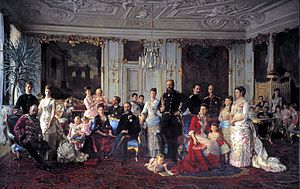Father-in-law of Europe

The father-in-law of Europe is a sobriquet which has been used to refer to two European monarchs of the late 19th and early 20th century: Christian IX of Denmark and Nicholas I of Montenegro, both on account of their children's marriages to foreign princes and princesses. The fact that each was a monarch of moderate or modest power (and thus a marriage would not threaten the delicate balance of power) allowed them to marry some of their many children to heirs of greater fortunes across the continent.
Christian IX of Denmark
[edit]The children of King Christian IX (1818–1906) and Queen Louise (1817–1898) of Denmark included:
- King Frederik VIII of Denmark (1843–1912)
- Queen Alexandra of the United Kingdom (1844–1925) queen consort of King Edward VII
- King George I of Greece (1845–1913)
- Empress Maria Feodorovna of Russia (1847–1928) empress consort of Emperor Alexander III
- Crown Princess Thyra of Hanover (1853–1933), who married Crown Prince Ernest Augustus
- Prince Valdemar of Denmark
Christian IX used to gather his children, children-in-law and grandchildren for the so-called Fredensborg days at Fredensborg Palace north of Copenhagen in the summer time.[1] Christian and Louise's grandchildren included King Christian X of Denmark, King George V of the United Kingdom, Emperor Nicholas II of Russia, King Constantine I of Greece and both King Haakon VII and his consort, Queen Maud of Norway.
Nicholas I of Montenegro
[edit]Nicholas I of Montenegro (1841–1921) was the father of:
- Zorka of Montenegro, who married King Peter I of Serbia
- Elena of Montenegro, who married King Victor Emmanuel III of Italy
- Anna of Montenegro, who married Prince Francis Joseph of Battenberg
- Two daughters who married brothers:
- Anastasia of Montenegro, who married Grand Duke Nicholas Nikolaevich of Russia after divorcing George, Duke of Leuchtenberg
- Milica of Montenegro, who married Grand Duke Peter Nikolaevich of Russia
See also
[edit]- Queen Victoria, who was known as the grandmother of Europe
- Louis IX, Landgrave of Hesse-Darmstadt, the most recent common ancestor of all current European monarchs since 2022
- John William Friso, Prince of Orange, until 2022, the most recent common ancestor of all European monarchs since World War II, current and former
- Miguel I of Portugal, another European king whose children strategically married into various European royal families
References
[edit]- ^ "Christian 9. med familie, 1886". De Danske Kongers Kronologiske Samling. Retrieved 2011-06-23.
